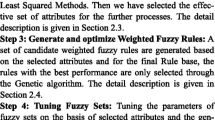Abstract
As individuals have intrigues in their wellbeing now a days, advancement of therapeutic area application has been a standout amongst the most dynamic exploration territories. One case of the restorative area application is the identification framework for coronary illness taking into account. A weighted fuzzy standard based clinical decision support system is displayed for the conclusion of coronary illness, consequently acquiring learning from the clinical information. The proposed heart disease risk level prediction system using fuzzy and genetic for the risk forecast of heart patients comprises of two stages: (1) mechanized methodology for the era of weighted fuzzy rules and (2) building up a fuzzy principle based heart disease risk level prediction using genetic algorithm. At this point, the fuzzy framework is developed as per the weighted fuzzy standards and picked better qualities cases. In this study, a system that can capably locate the fundamentals to anticipate the risk level of patients in perspective of the given parameter about their wellbeing. The principle commitment of this study is to help a non-specialized doctors to settle on right choice about the coronary illness risk level. The framework’s execution is assessed and compared as far as rules precision concerned and the outcomes demonstrates that the framework has incredible potential in foreseeing the coronary illness risk level more precisely.
















Similar content being viewed by others
References
AlMuhaideb S, Menai MEB (2014) A new hybrid metaheuristic for medical data classification. Int J Metaheuristics 3(1):59–80
Anooj PK (2012) Clinical decision support system: risk level prediction of heart disease using weighted fuzzy rules. J King Saud Univ Comput Inf Sci 24:27–40
Antonio G, Perez R (1998) Completeness and consistency conditions for learning fuzzy rules. Fuzzy Sets Syst 96:37–51
Barone JM (1992) Pruning fuzzy decision trees. In: Proceedings of 2nd international conference on fuzzy logic neural networks, Tizuka, Japan, pp 321–324
Cordón O, Herrera F (1997) A three-stage evolutionary process for learning descriptive and approximate fuzzy-logic-controller knowledge bases from examples. Int J Approx Reason 17:369–407
González A, Pérez R (1996) A learning system of fuzzy control rules. In: Herrera F, Verdegay JL (eds) Genetic algorithms and soft computing. Physica-Verlag, Berlin, pp 202–225
González A, Pérez R (1999) SLAVE: a genetic learning system based on an iterative approach. IEEE Trans Fuzzy Syst 7(2):176–191
González A, Pérez R, Verdegay JL (1994) Learning the structure of a fuzzy rule: a genetic approach. In: Proceedings of European congress on fuzzy and intelligent technologies (EUFIT), Aachen, Germany, Sept. 1993, vol 2, pp 814–819
Michalski RS (1986) Understanding the nature of learning. In: Michalski RS, Carbonell JG, Mitchell TM (eds) Machine learning: an artificial intelligence approach, vol 2. Morgan Kaufmann, San Mateo, CA, pp 3–26
Parodi A, Bonelli P (1993) A new approach to fuzzy classifier system. In: Proceedings of 5th international conference on genetic algorithms, Los Altos, CA, pp 223–230
Patil SB, Kumaraswamy YS (2009) Intelligent and effective heart attack prediction sys-tem using data mining and artificial neural network. Eur J Sci Res 31(4):642–656
Setiawan NA, Venkatachalam PA, Hani AFM (2009) Diagnosis of coronary artery disease using artificial intelligence based decision support system. In: Proceedings of the international conference on man-machine systems, Batu Ferringhi, Penang, 11–13 October 2009
Sharma P (2008) Time weighted miner (an efficient method for seasonal mining on a time-variant database). In: International conference on data management, ICDM 2008
Sharma P, Saxena K (2012) Temporal weighted association rule mining for classification. Int J Comput Theory Eng 4(5):816–820
Sharma P, Saxena K, Sharma R (2015) Efficient heart disease prediction system using decision tree. In: International conference on computing, communication & automation, Noida, pp 72–77
Sharma P, Saxena K, Sharma R (2016) Heart disease prediction system evaluation using C4.5 rules and partial tree. In: Behera H, Mohapatra D (eds) Computational intelligence in data mining—volume 2. Advances in intelligent systems and computing, vol 411. Springer, New Delhi
Srinivas K, Kavitha Rani B, Govrdhan A (2011) Application of data mining techniques in healthcare and prediction of heart attacks. Int J Comput Sci Eng 02(02):250–255
Tallón-Ballesteros AJ, Hervás-Martínez C, Riquelme JC, Ruiz R (2013) Feature selection to enhance a two-stage evolutionary algorithm in product unit neural networks for complex classification problems. Neurocomput 114:107–117
Tsipouras MG, Exarchos TP, Fotiadis DI, Kotsia AP, Vakalis KV, Naka KK, Michalis LK (2008) Automated diagnosis of coronary artery disease based on data mining and fuzzy modeling. IEEE Trans Inf Technol Biomed 12(4):447–458
Valenzuela-Rendón M (1991) The fuzzy classifier system: motivations and first results in Proceedings of the 1st Workshop on Parallel Problem Solving from Nature. Berlin: Springer-Verlag, pp. 330–334.
Zadeh LA (1965) Fuzzy sets. Inf Control 8(3):338–353
Zadeh LA (1975) The concept of a linguistic variable and its applications to approximate reasoning. Inf Sci 8(Part I):199–249
Author information
Authors and Affiliations
Corresponding author
Electronic supplementary material
Below is the link to the electronic supplementary material.
Rights and permissions
About this article
Cite this article
Sharma, P., Saxena, K. Application of fuzzy logic and genetic algorithm in heart disease risk level prediction. Int J Syst Assur Eng Manag 8 (Suppl 2), 1109–1125 (2017). https://doi.org/10.1007/s13198-017-0578-8
Received:
Revised:
Published:
Issue Date:
DOI: https://doi.org/10.1007/s13198-017-0578-8




